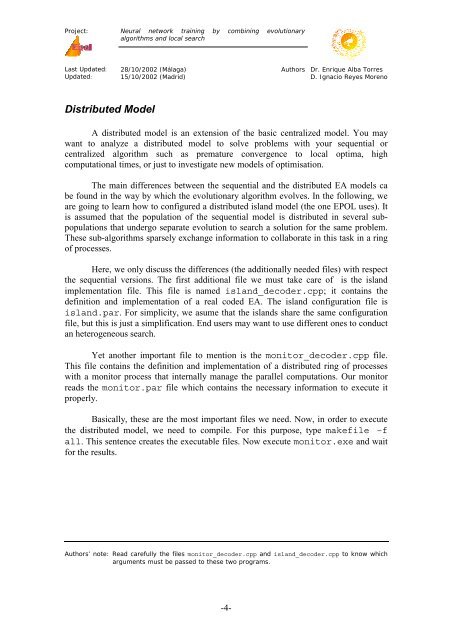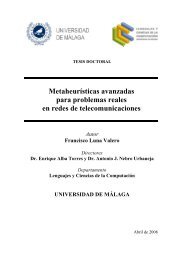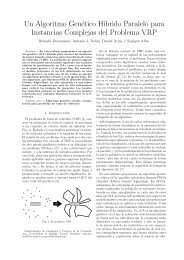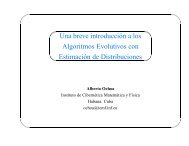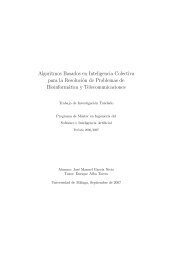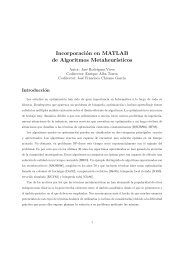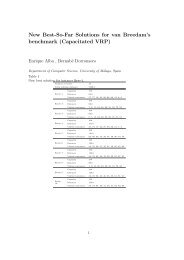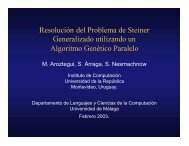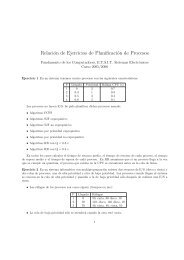Using the EPOL Library. Example GA - NEO
Using the EPOL Library. Example GA - NEO
Using the EPOL Library. Example GA - NEO
Create successful ePaper yourself
Turn your PDF publications into a flip-book with our unique Google optimized e-Paper software.
Project:<br />
Neural network training by combining evolutionary<br />
algorithms and local search<br />
Last Updated: 28/10/2002 (Málaga) Authors Dr. Enrique Alba Torres<br />
Updated: 15/10/2002 (Madrid) D. Ignacio Reyes Moreno<br />
Distributed Model<br />
A distributed model is an extension of <strong>the</strong> basic centralized model. You may<br />
want to analyze a distributed model to solve problems with your sequential or<br />
centralized algorithm such as premature convergence to local optima, high<br />
computational times, or just to investigate new models of optimisation.<br />
The main differences between <strong>the</strong> sequential and <strong>the</strong> distributed EA models ca<br />
be found in <strong>the</strong> way by which <strong>the</strong> evolutionary algorithm evolves. In <strong>the</strong> following, we<br />
are going to learn how to configured a distributed island model (<strong>the</strong> one <strong>EPOL</strong> uses). It<br />
is assumed that <strong>the</strong> population of <strong>the</strong> sequential model is distributed in several subpopulations<br />
that undergo separate evolution to search a solution for <strong>the</strong> same problem.<br />
These sub-algorithms sparsely exchange information to collaborate in this task in a ring<br />
of processes.<br />
Here, we only discuss <strong>the</strong> differences (<strong>the</strong> additionally needed files) with respect<br />
<strong>the</strong> sequential versions. The first additional file we must take care of is <strong>the</strong> island<br />
implementation file. This file is named island_decoder.cpp; it contains <strong>the</strong><br />
definition and implementation of a real coded EA. The island configuration file is<br />
island.par. For simplicity, we asume that <strong>the</strong> islands share <strong>the</strong> same configuration<br />
file, but this is just a simplification. End users may want to use different ones to conduct<br />
an heterogeneous search.<br />
Yet ano<strong>the</strong>r important file to mention is <strong>the</strong> monitor_decoder.cpp file.<br />
This file contains <strong>the</strong> definition and implementation of a distributed ring of processes<br />
with a monitor process that internally manage <strong>the</strong> parallel computations. Our monitor<br />
reads <strong>the</strong> monitor.par file which contains <strong>the</strong> necessary information to execute it<br />
properly.<br />
Basically, <strong>the</strong>se are <strong>the</strong> most important files we need. Now, in order to execute<br />
<strong>the</strong> distributed model, we need to compile. For this purpose, type makefile –f<br />
all. This sentence creates <strong>the</strong> executable files. Now execute monitor.exe and wait<br />
for <strong>the</strong> results.<br />
Authors’ note: Read carefully <strong>the</strong> files monitor_decoder.cpp and island_decoder.cpp to know which<br />
arguments must be passed to <strong>the</strong>se two programs.<br />
-4-


